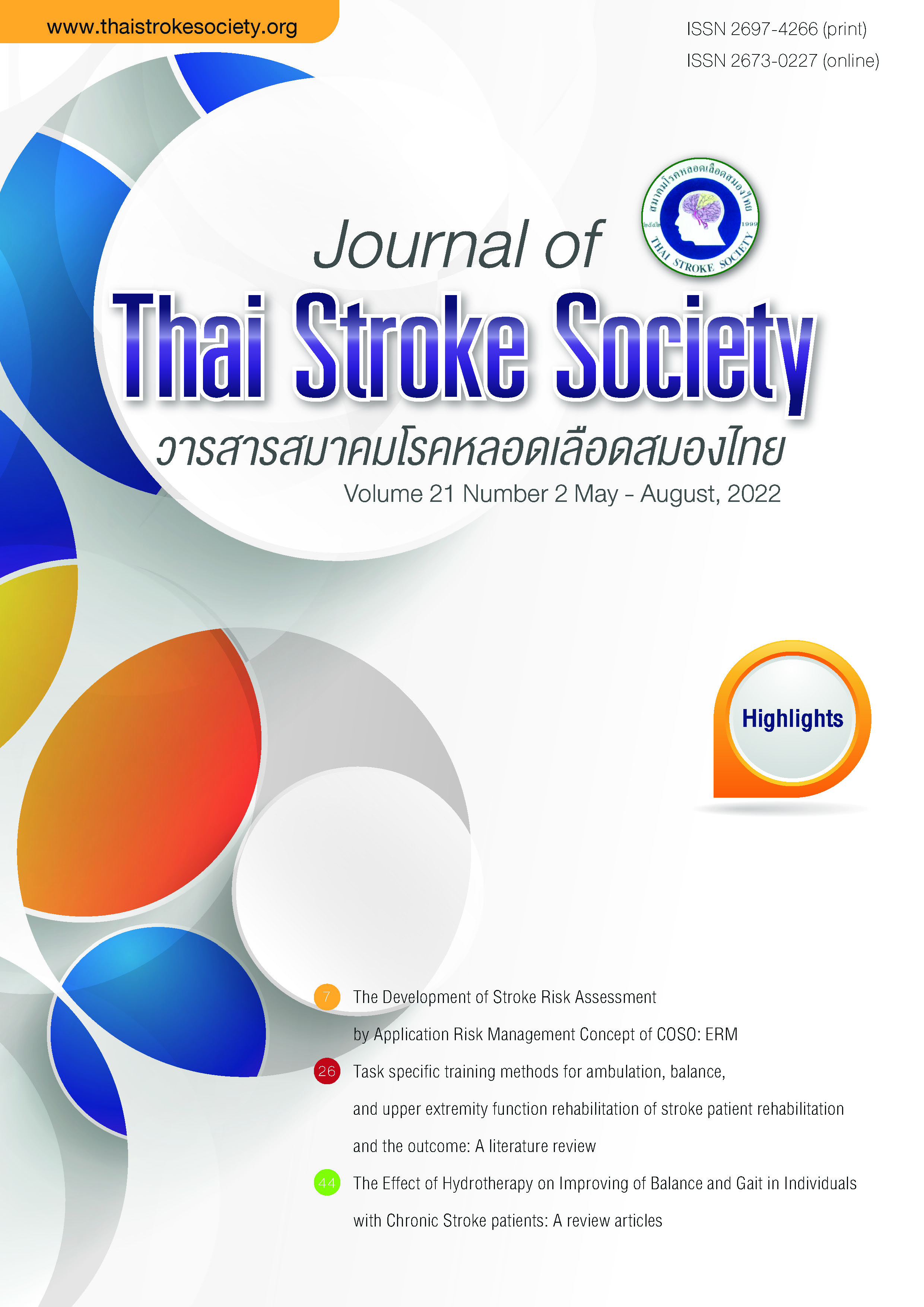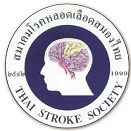The Development of Stroke Risk Assessment by Application Risk Management Concept of COSO : ERM
Keywords:
Stroke, risk management, COSO conceptAbstract
Objectives: 1) to study the risky factors towards the occurrence of stroke, 2) to design and develop the risk assessment form, 3) to analyze the risk towards the occurrence of stroke.
Research Methodology: it is mixed-method research, using the survey of factors leading to the development of the tools. The study was done with thirty patients who were diagnosed suffering from stroke until being admitted. The data analysis was carried out by using mathematics principles and descriptive statistics.
Research Result: 1) the risky factors towards stroke 21 factors, 2) the factors capable of predicting the risks towards stroke disease, it remains 14 factors, 3) the risk assessment form toward the stroke disease consists of 4 parts; 1) lists assessment of personal characteristics, 2) lists assessment of behaviors in daily life, 3) assessment of other relating factors, and 4) chart of risk assessment toward stroke.
Conclusion: 1) the factors found was an indicator toward the risk of stroke occurrence, 2) the application of risk management principles according to the COSO: ERM concept for designing and developing the risk assessment form towards the occurrence of stoke based on cause and effect, 3) the risk assessment form towards the occurrence of stroke is capable of predicting the tendency of the risky behaviors towards the occurrence of stroke accurately.
References
กรมการแพทย์ กระทรวงสาธารณสุข. Thailand Medical Services Profile 2015-2018 โรคหลอดเลือดสมอง. [อินเตอร์เน็ต]. [เข้าถึงเมื่อ 14 พฤศจิกายน 2564] เข้าถึงได้จาก: file:///C:/Users/acer/Downloads/5dfcb8d04702c760392358%20(1).pdf (วันที่25 ม.ค. 59).
ณฐกร นิลเนตร ชนัญญา จิระพรกุล และเนาวรัตน์ มณีนิล. ปัจจัยที่มีความสัมพันธ์กับการเกิดโรคหลอดเลือดสมองของผู้ป่วยความดันโลหิตสูงในพื้นที่จังหวัดบึงกาฬ. วารสารสุขศึกษา 2561;64.
Jittima Saengsuwan, Pathitta Suangpho & Somsak Tiamkao. Knowledge of Stroke Risk Factors and Warning Signs in Patients with Recurrent Stroke or Recurrent Transient Ischaemic Attack in Thailand. Journal of Clinical Medicine. 2020;9:1-2.
Rodgers A, Perkovic V.. A Randomized Trial of Intensive versus Standard Blood-pressure Control. N Engl J Med. 2016;23:2295.
Yiin Gabriel SC, Howard Dominic PJ, Paul Nicola LM, Li L, Luengo-Fernandez, R, Bull Linda M, et al. Age-Specific Incidence, Outcome, Cost and Projected Future Burden of Atrial Fibrillation-Related Embolic Vascular Events. Circulation. 2014;130:1236-44.
Kazim Husain, et al. Alcohol-induced hypertension: Mechanism and prevention. Worid Journal of cardiology. 2014;6:245-252.
Writing C, Lioyd-Jones DM, Morris PB, Ballantyne CM, Birtcher KK, Daly DD, Jr., et al. ACC Expert Consensus Decision Pathway on the Role of Non-Statin Therapies for LDL-Cholesterol Lowering in the management of Atherosclerotic Cardiovascular Disease Risk: A Report of the American Collehe of Cardiology Task Force on Clinical Expert Consensus Documents. J Am Coll Cardiol. 2016;68:92-125.
Nystrom T, Holzmann MJ, Sartipy U. Longterm risk of stroke in patients with type 1 and type 2 diabetes following coronary artery bypass grafting. J Am Heart Assoc. 2015; 4:e002411-e002411.
Teh WL, Abdin E, Vaingankar JA, Seow E, Sagayadevan V, Shafie S, et al. Prevalence of stroke, risk factors, disability and care needs in older adults in Singapore: results from the WiSE study. BMJ Open. 2018;8(3):e020285.
Boehme AK, Esenwa C, Elkind MS. Stroke Risk Factors, Genetics, and Prevention. Circ Res. 2017;120(3):472-95.
กานต์ธิชา กำแพงแก้ว วิไลพรรณ สมบุญตนนท์ และวีนัส ลีฬหกุล. ความสัมพันธ์ระหว่างการรับรู้ปัจจัยเสี่ยง การรับรู้อาการเตือนและพฤติกรรมการดูแลตนเองเพื่อป้องกันโรคหลอดเลือดสมองในผู้สูงอายุกลุ่มเสี่ยง. วารสารพยาบาลกระทรวงสาธารณสุข 2558;42-45.
Zeng, Y., He, G.-P., Yi, G.-H., Huang, Y.-J., Zhang, Q.-H., & He, L.-L. Knowledge of stroke warning signs and risk factors among patients with previous stroke or TIA in China. Journal of Clinical Nursing. 2012;21:2886-2895.
Mellor, R. M., Bailey, S., Sheppard, J., Carr, P., Quinn, T., Boyal, A., & McManus, R. J. Decisions and delays within stroke patients’ route to the hospital: a qualitative study. Annals of Emergency Medicine. 2015;65:278-2 7.
National Health Security Office. (2007). Risk of stroke. Bangkok: Ministry of Public Health.
Robins, G., Power, D., & Burgen, S. (1999). A wellness way of life. New York: McGraw-Hill.
จุฑารัตน์ ดวงจันทร์ตุ้ย และพีรยา มั่นเขตวิทย์. การสำรวจระดับความเสี่ยงต่ออาการเกิดโรคหลอดเลือดสมองของพนักงานขับรถโดยสารรับจ้างของสหกรณ์นครล้านนาเดินรถจำกัดจังหวัดเชียงใหม่. วารสารเทคนิคการแพทย์เชียงใหม่ 2556;46:43.
The Committee of Sponsoring Organizations of the Treadway Commission (COSO) (2004). Enterprise Risk Management - Integrated Framework. Retrieved on January 1, 2021. Available from: https ://www.coso.org/Documents/COSO-ERM-Executive-Summary.pdf
พงศ์เทพ วิวรรธนะเดช. การประเมินความเสี่ยงสุขภาพและการสร้างแบบจำลอง, 2561.
Teasell, R., & Viana, R. (2014). Stroke rehabilitation clinician handbook. Canada: Western University.
Hubbard IJ, Wass S, Pepper E. Stroke in older survivors of ischemic stroke: standard care or something different? Geriatrics 2017;2:18.
สันติชัย ศรีปณิธาน. การศึกษาโรคหลอดเลือดสมองตีบหรืออุดตันเฉียบพลันทีได้รับการรักษาด้วยยาละลายลิ่มเลือดทางหลอดเลือดดำในโรงพยาบาลแพร. วารสารโรงพยาบาลแพร่. 2560;4.
Berkhemer OA, Fransen PS, Beumer D, van den Berg LA, Lingsma HF, Yoo AJ, etal. A Randomized Trial of Intraarterial Treatment for Acute Ischemic Stroke. N Engl J Med 2015;372:11.
Polit D. F., & Beck C.T. Essentials of Nursing Research: Appraising Evidence for Nursing Practice.(8th Ed). Philadelphia: Lippincott Williams, & Wilkins; 2014.
Downloads
Published
How to Cite
Issue
Section
License
Copyright (c) 2022 Journal of Thai Stroke Society

This work is licensed under a Creative Commons Attribution-NonCommercial-NoDerivatives 4.0 International License.
ข้อความภายในบทความที่ตีพิมพ์ในวารสารสมาคมโรคหลอดเลือดสมองไทยเล่มนี้ ตลอดจนความรับผิดชอบด้านเนื้อหาและการตรวจร่างบทความเป็นของผู้นิพนธ์ ไม่เกี่ยวข้องกับกองบรรณาธิการแต่อย่างใด การนำเนื้อหา ข้อความหรือข้อคิดเห็นของบทความไปเผยแพร่ ต้องได้รับอนุญาตจากกองบรรณาธิการอย่างเป็นลายลักษณ์อักษร ผลงานที่ได้รับการตีพิมพ์ในวารสารเล่มนี้ถือเป็นลิขสิทธิ์ของวารสาร





